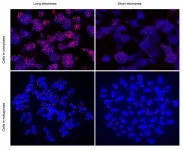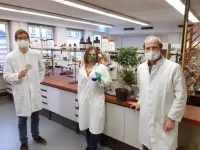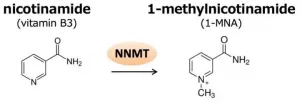(Press-News.org) Patients with severe COVID-19 disease have significantly shorter telomeres, according to a study conducted by researchers at the Spanish National Cancer Research Centre (CNIO) in collaboration with the COVID-IFEMA Field Hospital, published in the journal Aging. The study, led by Maria A. Blasco and whose first authors are Raúl Sánchez and Ana Guío-Carrión, postulates that telomere shortening as a consequence of the viral infection impedes tissue regeneration and that this is why a significant number of patients suffer prolonged sequelae.
Blasco was already developing a therapy to regenerate lung tissue in pulmonary fibrosis patients; she now believes that this treatment -which should still take at least a year and a half to become available- could also help those who have lung lesions remaining after overcoming COVID-19.
Telomeres and tissue regeneration
The Telomeres and Telomerase Group, led by Blasco at the CNIO, has been researching the role of telomeres in tissue regeneration for decades. Telomeres are structures that protect the chromosomes within each cell of the organism. It is known that telomere length is an indicator of ageing: each time a cell divides, its telomeres shorten until they can no longer perform their protective function and the cell, which now becomes damaged, stops dividing. Throughout life, cells are constantly dividing to regenerate tissues, and when they stop doing so because the telomeres are too short, the body ages.
In recent years, researchers have shown in mice that it is possible to reverse this process by activating the production of telomerase, which is the enzyme in charge of making the telomeres longer. In animals, telomerase activation is effective in treating diseases associated with ageing and telomere damage, such as pulmonary fibrosis.
COVID-19 as a regenerative disease
In pulmonary fibrosis the lung tissue develops scars and becomes rigid, causing a progressive loss of breathing capacity. The CNIO group has shown in previous studies that one of the causes of the disease is damage to the telomeres of the cells involved in regenerating the lung tissue, the alveolar type II pneumocytes. And these are precisely the cells that the SARS-CoV-2 coronavirus infects in lung tissue.
"When I read that type II alveolar pneumocytes were involved in COVID-19, I immediately thought that telomeres might be involved," says Blasco.
In the Aging paper, the researchers write: "It caught our attention that a common outcome of SARS-CoV-2 infection seems to be the induction of a fibrosis-like phenotype in lung and kidney, suggesting that the viral infection may be exhausting the regenerative potential of tissues."
The authors propose that it is the short telomeres that hamper tissue regeneration after infection. As Blasco explains, "we know that the virus infects alveolar type II pneumocytes and that these cells are involved in lung regeneration; we also know that if they have telomeric damage they cannot regenerate, which induces fibrosis. This is what is seen in patients with lung lesions after COVID-19: we think they develop pulmonary fibrosis because they have shorter telomeres, which limits the regenerative capacity of their lungs."
Samples of patients in a field hospital
The data presented in the 'Aging' paper provide evidence in favour of this hypothesis, by finding an association between greater severity of COVID-19 and shorter telomeres.
Despite the difficulties arising from conducting research at the height of the pandemic -"the hospital facilities for COVID-19 patients were overwhelmed," Blasco says- it was possible to analyse the telomeres of 89 patients admitted to the field hospital at the IFEMA in Madrid using several techniques.
As in the general population, the average length of the telomeres decreased as age increased in the patients studied. Furthermore, as the most severe patients are also the oldest patients, there is also a correlation between greater severity and shorter telomere length.
What could not be foreseen, and this is the most important finding, is that the telomeres of the most seriously ill patients were also shorter, irrespective of age.
The researchers write: "Interestingly, we also found that those patients who have more severe COVID-19 pathologies have shorter telomeres at different ages compared to patients with milder disease."
And they add: "These findings demonstrate that molecular hallmarks of ageing, such as the presence of short telomeres, can influence the severity of COVID-19 pathologies."
Gene therapy for patients with post-COVID-19 pulmonary injury
The intention of the researchers is now to demonstrate a causal relationship between reduced telomere length and pulmonary sequelae of COVID-19. To do this, they will infect mice that have short telomeres and are not able to produce telomerase with SARS-CoV-2; without telomerase, the telomeres cannot be repaired and as a consequence lung tissue regeneration cannot take place. If the hypothesis of Blasco's group is correct, mice with short telomeres and without telomerase should develop more severe pulmonary fibrosis than normal mice.
Confirmation that short telomeres hamper the recovery of severe patients would open the door to new treatment strategies, such as therapies based on telomerase activation.
"Given that short telomeres can be made longer again by telomerase, and given that in previous studies we have shown that telomerase activation has a therapeutic effect on diseases related to short telomeres, such as pulmonary fibrosis, it is tempting to speculate that this therapy could improve some of the pathologies that remain in COVID-19 patients once the viral infection has been overcome, such as pulmonary fibrosis."
Last year the CNIO and the Autonomous University of Barcelona, UAB, created a new spin-off company, Telomere Therapeutics, with the specific aim of developing a telomerase-based gene therapy for the treatment of different pathologies related to telomere shortening, such as pulmonary fibrosis and renal fibrosis. This would be a potentially useful type of therapy in patients with remaining lung damage after COVID-19.
INFORMATION:
The study was funded by the Spanish Ministry of Science and Innovation, the National Institute of Health Carlos III, the Community of Madrid, the Botín Foundation and Banco Santander through Santander Universidades, and World Cancer Research.
Reference article: Shorter telomere lengths in patients with severe COVID-19 disease. Raul Sanchez-Vazquez, Ana Guío-Carrión, Antonio Zapatero-Gaviria, Paula Martínez, Maria A. Blasco (Aging, 2021). DOI: https://doi.org/10.18632/aging.202463
NEW YORK, NY (Jan. 11, 2021)--A new study has found that up to 20% of glioblastomas--an aggressive brain cancer--are fueled by overactive mitochondria and may be treatable with drugs currently in clinical trials.
Mitochondria are responsible for creating the energy that fuels all cells. Though they are usually less efficient at producing energy in cancer, tumor cells in this newly identified type of glioblastoma rely on the extra energy provided by overactive mitochondria to survive.
The study, by cancer scientists at Columbia University's Vagelos College ...
For some years, an active substance from the leaves of an ornamental plant has been regarded as a possible forerunner of a new group of potent drugs. So far, however, it has been very laborious to manufacture it in large quantities. That could now change: Researchers at the University of Bonn (Germany) have identified a bacterium that produces the substance and can also be easily cultivated in the laboratory. The results are published in the journal Nature Communications.
The coralberry currently once again adorns many living rooms: In winter it bears bright red fruits, which make it a popular ornamental plant at this time of year. For pharmacists, however, it is interesting for a different reason: It contains ...
CHAMPAIGN, Ill. -- For years, researchers have worked to repurpose excess atmospheric carbon dioxide into new chemicals, fuels and other products traditionally made from hydrocarbons harvested from fossil fuels. The recent push to mitigate the climactic effects of greenhouse gases in the atmosphere has chemists on their toes to find the most efficient means possible. A new study introduces an electrochemical reaction, enhanced by polymers, to improve CO2-to-ethylene conversion efficiency over previous attempts.
The results of the study led by University of Illinois Urbana-Champaign chemistry ...
Metabolites are organic molecules that take part in or are created during the biochemical reactions constantly taking place in an organism. For the human body, more than 110,000 metabolites have been identified. Metabolites play a role in metabolic syndrome, which is the situation in which several medical conditions occur simultaneously; the conditions include obesity, high blood pressure and high blood sugar. Metabolic syndrome is associated with a higher risk of developing cardiovascular disease, type-2 diabetes and different kinds of cancer. The presence of certain metabolites can be an indicator for particular pathological ...
This most likely explains the augmented response of the immune system and the more severe disease progression. However, certain hypertension-reducing drugs known as ACE inhibitors can have a beneficial effect. They not only lower blood pressure, but also counteract immune hyperactivation. The scientists have now published their findings in the journal Nature Biotechnology.
More than one billion people worldwide suffer from high blood pressure, or hypertension. Of the more than 75 million people around the world who have become infected with the SARS-CoV-2 virus worldwide so far, more than 16 million also have hypertension. These patients are more likely to become severely ill, which in turn results in an increased ...
NEW YORK, NY (Jan. 11, 2021)--Thousands of different genetic mutations have been implicated in cancer, but a new analysis of almost 10,000 patients found that regardless of the cancer's origin, tumors could be stratified in only 112 subtypes and that, within each subtype, the Master Regulator proteins that control the cancer's transcriptional state were virtually identical, independent of the specific genetic mutations of each patient.
The study, published Jan. 11 in Cell, confirms that Master Regulators provide the molecular logic that integrates the effect ...
Philadelphia, January 11, 2021 - Children and adolescents with a family history of suicide attempts have lower executive functioning, shorter attention spans, and poorer language reasoning than those without a family history, according to a new study by researchers from the Lifespan Brain Institute (LiBI) of Children's Hospital of Philadelphia (CHOP) and the University of Pennsylvania. The study is the largest to date to examine the neurocognitive functioning of youth who have a biological relative who made a suicide attempt.
The findings, which were first published online last March, were published in the January 2021 edition of The Journal of Child Psychology and Psychiatry.
Researchers looked at 3,507 youth aged 8 to 21. Of those, ...
Russian researchers have proposed a new method for synthesizing high-quality graphene nanoribbons -- a material with potential for applications in flexible electronics, solar cells, LEDs, lasers, and more. Presented in The Journal of Physical Chemistry C, the original approach to chemical vapor deposition, offers a higher yield at a lower cost, compared with the currently used nanoribbon self-assembly on noble metal substrates.
Silicon-based electronics are steadily approaching their limits, and one wonders which material could give our devices the next big push. Graphene, the 2D sheet of carbon atoms, comes to mind but for all its celebrated electronic properties, it does not have what it takes: Unlike silicon, graphene does not have the ability to switch between ...
CHICAGO (January 11, 2021): A new study of liver transplant centers confirms that non-Hispanic white patients get placed on liver transplant waitlists at disproportionately higher rates than non-Hispanic Black patients. However, researchers went a step further as they identified key reasons for that disparity: disproportionate access to private health insurance, travel distance to transplant centers, and a potential lack of knowledge among both practitioners and patients about available options. The study was selected for the 2020 Southern Surgical Association Program and published as an "article in press" on the website of the Journal of the American College of Surgeons in advance of print.
"We found that the Black population was underrepresented at the vast majority of centers, ...
All-solid-state batteries are the next-generation batteries that can simultaneously improve the stability and capacity of existing lithium batteries. The use of non-flammable solid cathodes and electrolytes in such batteries considerably reduces the risk of exploding or catching fire under high temperatures or external impact and facilitates high energy density, which is twice that of lithium batteries. All-solid-state batteries are expected to become a game changer in the electric vehicle and energy storage device markets. Despite these advantages, the low ionic conductivity of solid electrolytes combined with their high interfacial resistance and rapid deterioration reduce battery performance and life, thus limiting their commercialization.
The ...






